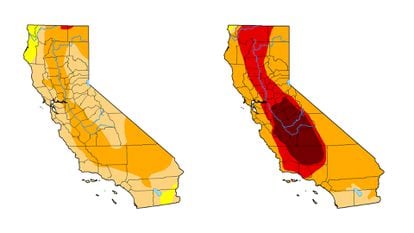/cloudfront-eu-central-1.images.arcpublishing.com/prisa/JR3CWXANUCLNQYPEGRF6XNHEME.jpg)
The rain seems to be soothing California. Officials have asked the people of the state to be patient. After another downpour weekend, a new storm is forecast to bring fresh rain and snow to the region, which has seen dramatic news reports of flooding, tens of thousands of evacuations, landslides and rescues for the first time in years. Meteorologists have tracked the tracks of eight storms since December. On Sunday afternoon the ninth entered the beach, which is believed to be the last. This, moderate, will continue its course eastward throughout Monday, adding a few more millimeters to the abundance that has fallen since December 27. The big question on everyone’s mind is how much these events have affected the long drought California has been experiencing. Four years ago.
State officials are set to devote Monday to assessing the damage left by the rain as it winds down. At least 20 people have died in recent weeks in incidents linked to heavy rain and thunderstorms. More than 40 districts maintained emergency declaration on Monday. Among these, Los Angeles is the most populous urban core. The White House declared a state of disaster for the region on Saturday, allowing state officials to call for special resources to help affected people in Merced, Sacramento and Santa Cruz counties in the center and north of the state.
The University of California, Berkeley’s observatory reported this Monday that 126 centimeters of snow had fallen since last Friday. This has prompted an avalanche warning in California’s Central Sierra that could affect the vicinity of Lake Tahoe, a popular tourist destination.
The Meteorological Department has indicated that the dry season will begin in the institute this Tuesday. Residents of Southern California will be the first to notice it. The change will come in the center and north of the state on Thursday as light rain is still expected for the next two days.
A string of storms caused by a series of events known as atmospheric rivers has also left a message of good news. California’s dam system, home to 40 million people, is showing levels not seen in years. This storage network, fed during the monsoon season from November to March, accounts for 60% of the state’s supply.

Information is the first tool against climate change. Subscribe to her.
In total, the network is made up of 15 reserves. The rainfall in the past three weeks, nine of which have already exceeded the average recorded in recent years. The other four are close to the average, a mark they can reach as the snow melts in the mountain ranges. The most important of these reserves is Lake Shasta in the north. It went from 280 meters above sea level last December to almost 300 meters on January 15. Currently, it is at 50% of its capacity.
Lake Oroville was in 2022 One of the main faces To illustrate the devastation left by a severe drought in California. Low levels of the lake during the summer exposed mountains which, under normal circumstances, would have been hidden by the water table. At that time Oro was 40% full. The lake has also benefited from the recent rains. It rises about 12 meters above sea level, keeping its level at 60% of its capacity. This is 87 meters above the level recorded in early 2021. It is a stock that has grown more in recent weeks.
Experts have asked for a little more time to assess whether the string of storms has ended California’s more than three-year drought. The drought monitoring system managed by the Union Department of Agriculture shows a drastic change over the past two weeks. Map indicating that 95% of the state is now recording moderate drought. Today only 0.32% of the land area experiences severe drought. Three months ago, this intensity was 41%. 16% of California has severe drought, exceptional drought. 0% this week.
The end of a three-year period marked by drought will be imposed on California in the next two months. February and March should be rainy. It is better if they are in moderation. A history of success already exists. April 7, 2017, Governor Jerry Brown ended a five-year drought in California after a winter of record rainfall and a water conservation effort imposed by state officials. Both these requirements have been repeated after six years. We have to wait and see if there is good news in April.

/cloudfront-eu-central-1.images.arcpublishing.com/prisa/JR3CWXANUCLNQYPEGRF6XNHEME.jpg)



